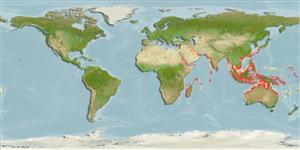Environment: milieu / climate zone / depth range / distribution range
Ecologia
marinhas; Água doce; estuarina; intervalo de profundidade 0 - ? m. Tropical
Indo-West Pacific: the most widespread of the four species of Rhynchorhamphus, found from Persian Gulf through Arabian Sea and Bay of Bengal through the Western Central Pacific north to Taiwan and Hong Kong and east to New Guinea and northern Australia.
Comprimento de primeira maturação / Tamanho / Peso / Idade
Maturity: Lm 15.8, range 15 - 16.5 cm
Max length : 31.0 cm macho/indeterminado; (Ref. 10943)
Espinhos dorsais (total): 0; Raios dorsais (total): 13-17; Espinhos anais 0; Raios anais : 13 - 16; Vértebras: 54 - 59. Very strongly pronounced domed upper jaw which is the longest and most arched of the four species of Rhynchorhamphus.
Found in inshore waters (Ref. 75154). Enters freshwaters (Ref 13446).
Ciclo de vida ou comportamento de acasalamento
Maturidade | Reprodução | Desova | Ovos | Fecundidade | Larvas
Collette, B.B. and J. Su, 1986. The halfbeaks (Pisces, Beloniformes, Hemiramphidae) of the Far East. Proc. Acad. Nat. Sci. Philadelphia 138(1):250-301. (Ref. 10943)
Status na Lista Vermelha da UICN (Ref. 130435)
Ameaça para os humanos
Harmless
Uso pelos humanos
Pescarias: pouco comercial
Mais informação
ColaboradoresFotosStamps, Coins Misc.SonsCiguateraVelocidadeTipo de nataçãoÁrea branquialOtólitosCérebrosVisão
Ferramentas
Relatórios especiais
Baixar XML
Fontes da internet
Estimates based on models
Preferred temperature (Ref.
123201): 24.9 - 29.2, mean 28.3 °C (based on 1440 cells).
Índice de diversidade filogenética (Ref.
82804): PD
50 = 0.5625 [Uniqueness, from 0.5 = low to 2.0 = high].
Bayesian length-weight: a=0.00245 (0.00129 - 0.00466), b=2.94 (2.78 - 3.10), in cm total length, based on LWR estimates for this species & (Sub)family-body (Ref.
93245).
Nível Trófico (Ref.
69278): 3.1 ±0.2 se; based on size and trophs of closest relatives
Generation time: 0.8 ( na - na) years. Estimated as median ln(3)/K based on 1
growth studies.
Resiliência (Ref.
120179): Elevada, tempo mínimo de duplicação da população menor que 15 meses (K>1).
Fishing Vulnerability (Ref.
59153): Low vulnerability (16 of 100).
